Abstract
Gene targeting at the immunoglobulin loci of B cells is an efficient tool for studying immunoglobulin expression or generating chimeric antibodies. We have shown that vector integration induced by human immunoglobulin G1 (IgG1) insertion vectors results in subsequent vector excision mediated by the duplicated target sequence, whereas replacement events which could be induced by the same constructs remain stable. We could demonstrate that the distribution of the vector homology strongly influences the genetic stability obtained. To this end we developed a novel type of a heavy chain replacement vector making use of the heavy chain class switch recombination sequence. Despite the presence of a two-sided homology this construct is universally applicable irrespective of the constant gene region utilized by the B cell. In comparison to an integration vector the frequency of stable incorporation was strongly increased, but we still observed vector excision, although at a markedly reduced rate. The latter events even occurred with circular constructs. Linearization of the construct at various sites and the comparison with an integration vector that carries the identical homology sequence, but differs in the distribution of homology, revealed the following features of homologous recombination of immunoglobulin genes: (i) the integration frequency is only determined by the length of the homology flank where the cross-over takes place; (ii) a 5' flank that does not meet the minimum requirement of homology length cannot be complemented by a sufficient 3' flank; (iii) free vector ends play a role for integration as well as for replacement targeting; (iv) truncating recombination events are suppressed in the presence of two flanks. Furthermore, we show that the switch region that was used as 3' flank is non-functional in an inverted orientation.
Full text
PDF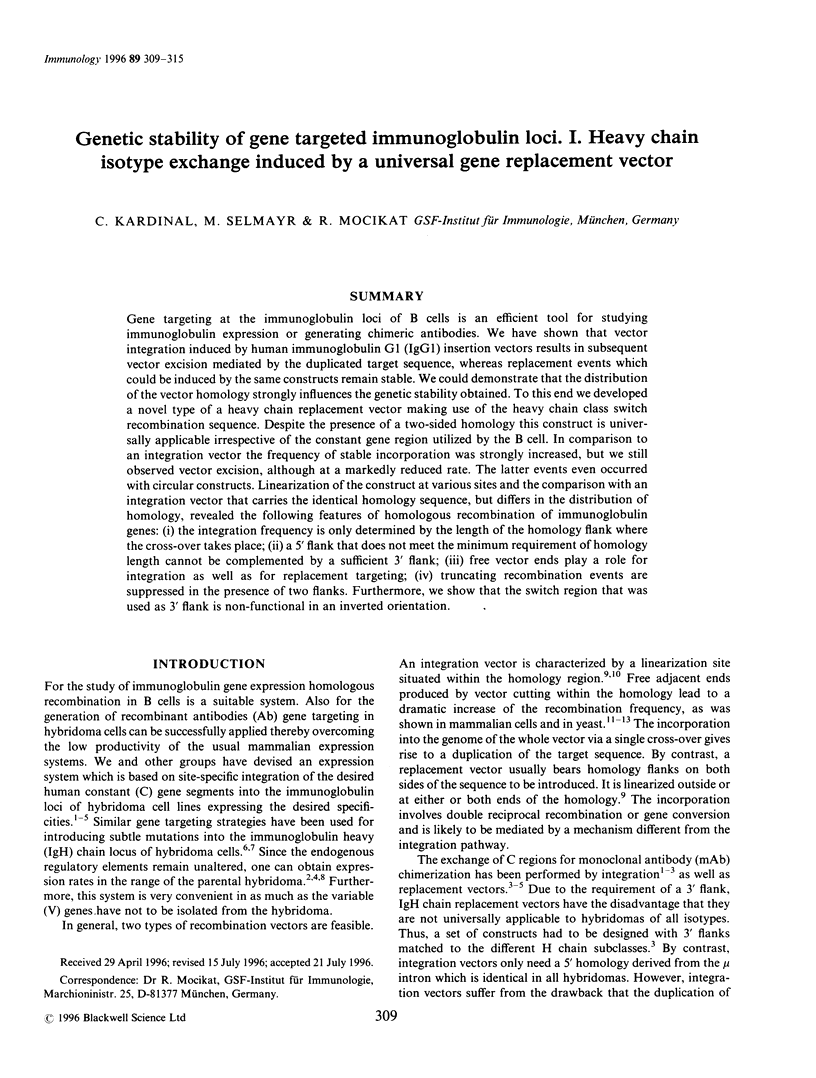
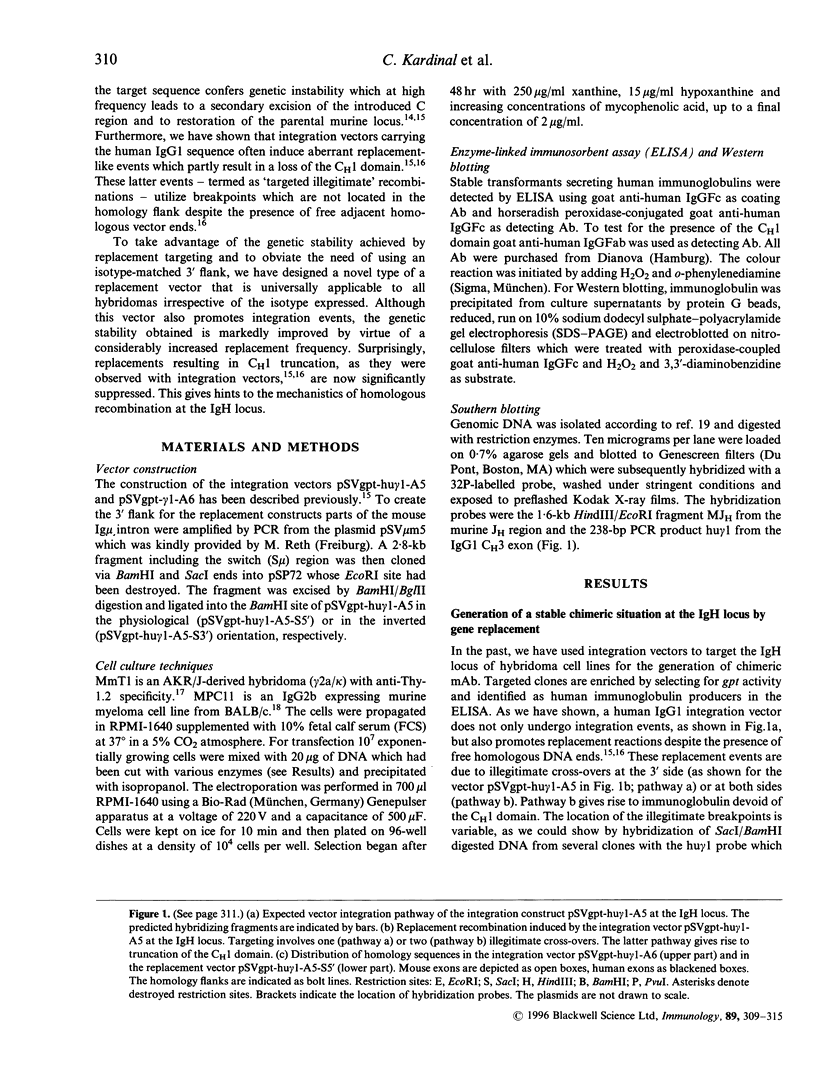
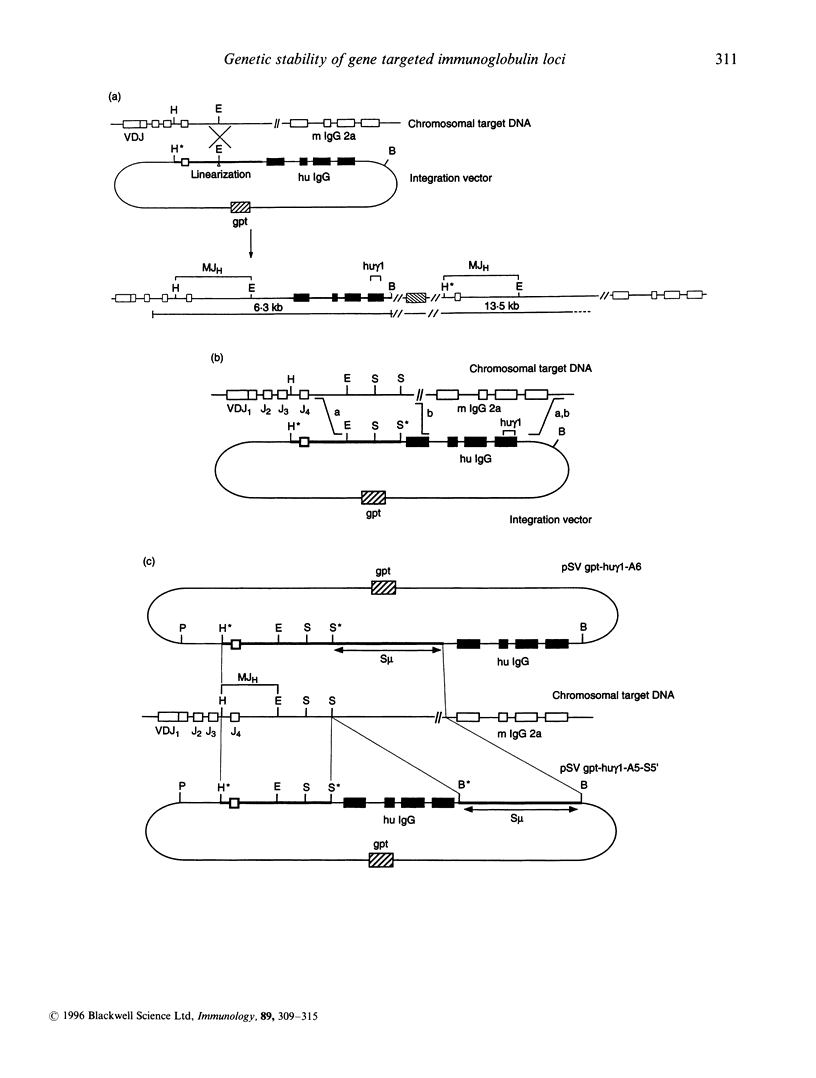
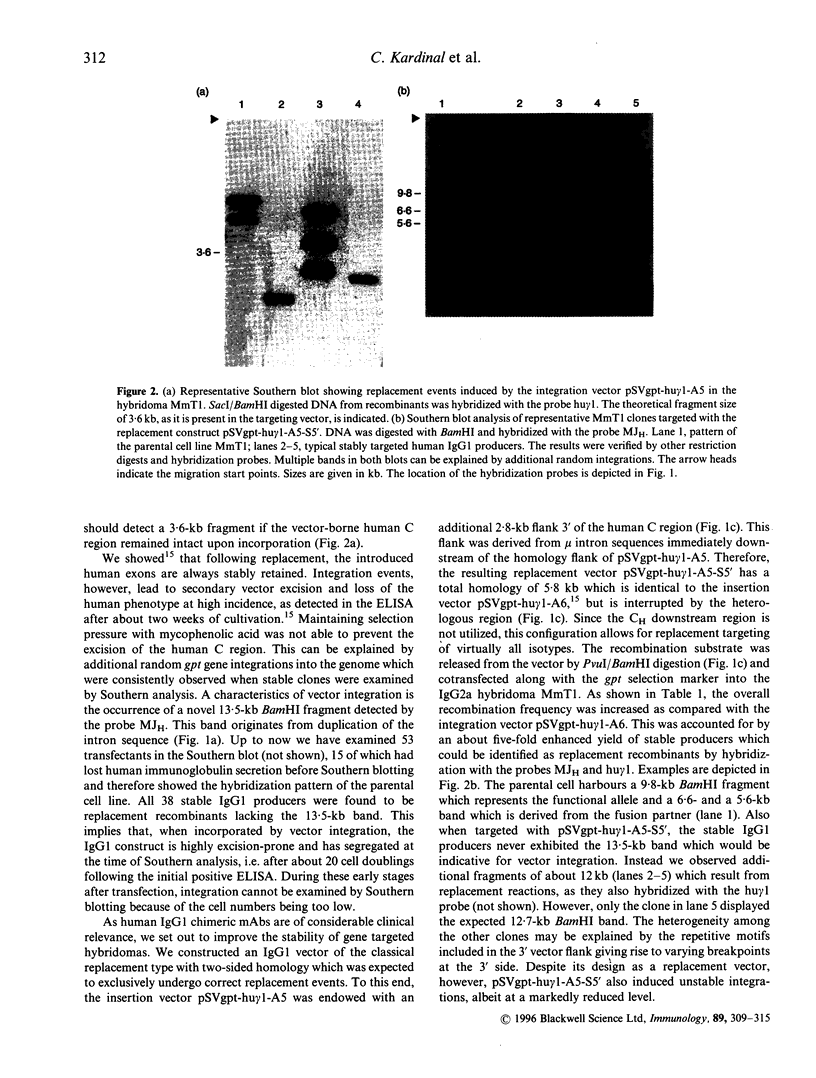

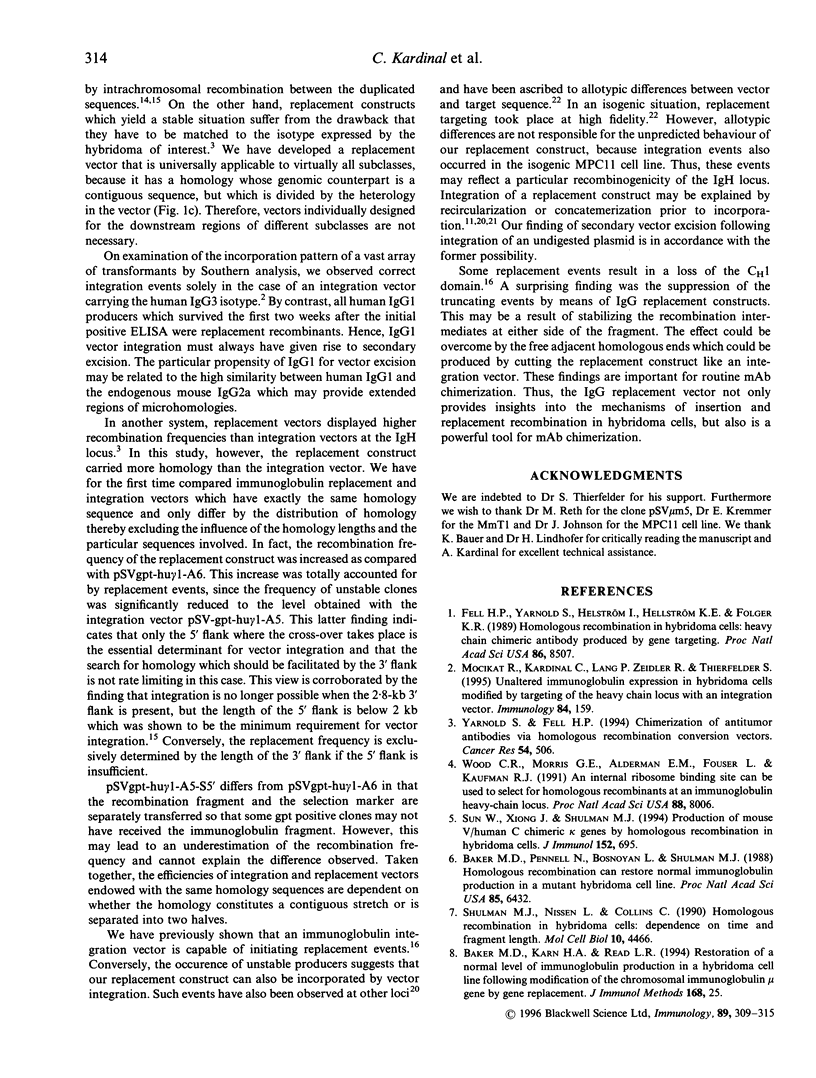
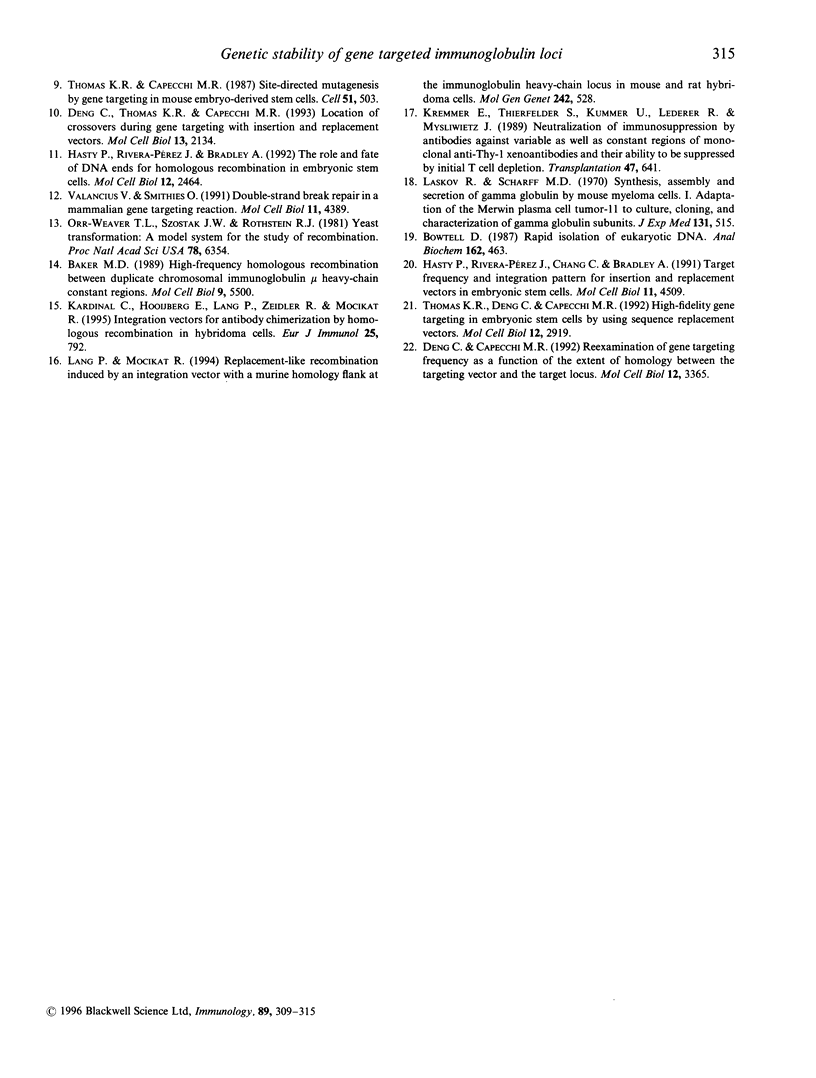
Images in this article
Selected References
These references are in PubMed. This may not be the complete list of references from this article.
- Baker M. D. High-frequency homologous recombination between duplicate chromosomal immunoglobulin mu heavy-chain constant regions. Mol Cell Biol. 1989 Dec;9(12):5500–5507. doi: 10.1128/mcb.9.12.5500. [DOI] [PMC free article] [PubMed] [Google Scholar]
- Baker M. D., Karn H. A., Read L. R. Restoration of a normal level of immunoglobulin production in a hybridoma cell line following modification of the chromosomal immunoglobulin mu gene by gene replacement. J Immunol Methods. 1994 Jan 12;168(1):25–32. doi: 10.1016/0022-1759(94)90205-4. [DOI] [PubMed] [Google Scholar]
- Baker M. D., Pennell N., Bosnoyan L., Shulman M. J. Homologous recombination can restore normal immunoglobulin production in a mutant hybridoma cell line. Proc Natl Acad Sci U S A. 1988 Sep;85(17):6432–6436. doi: 10.1073/pnas.85.17.6432. [DOI] [PMC free article] [PubMed] [Google Scholar]
- Deng C., Capecchi M. R. Reexamination of gene targeting frequency as a function of the extent of homology between the targeting vector and the target locus. Mol Cell Biol. 1992 Aug;12(8):3365–3371. doi: 10.1128/mcb.12.8.3365. [DOI] [PMC free article] [PubMed] [Google Scholar]
- Deng C., Thomas K. R., Capecchi M. R. Location of crossovers during gene targeting with insertion and replacement vectors. Mol Cell Biol. 1993 Apr;13(4):2134–2140. doi: 10.1128/mcb.13.4.2134. [DOI] [PMC free article] [PubMed] [Google Scholar]
- Fell H. P., Yarnold S., Hellström I., Hellström K. E., Folger K. R. Homologous recombination in hybridoma cells: heavy chain chimeric antibody produced by gene targeting. Proc Natl Acad Sci U S A. 1989 Nov;86(21):8507–8511. doi: 10.1073/pnas.86.21.8507. [DOI] [PMC free article] [PubMed] [Google Scholar]
- Hasty P., Rivera-Pérez J., Bradley A. The role and fate of DNA ends for homologous recombination in embryonic stem cells. Mol Cell Biol. 1992 Jun;12(6):2464–2474. doi: 10.1128/mcb.12.6.2464. [DOI] [PMC free article] [PubMed] [Google Scholar]
- Hasty P., Rivera-Pérez J., Chang C., Bradley A. Target frequency and integration pattern for insertion and replacement vectors in embryonic stem cells. Mol Cell Biol. 1991 Sep;11(9):4509–4517. doi: 10.1128/mcb.11.9.4509. [DOI] [PMC free article] [PubMed] [Google Scholar]
- Kardinal C., Hooijberg E., Lang P., Zeidler R., Mocikat R. Integration vectors for antibody chimerization by homologous recombination in hybridoma cells. Eur J Immunol. 1995 Mar;25(3):792–797. doi: 10.1002/eji.1830250325. [DOI] [PubMed] [Google Scholar]
- Kremmer E., Thierfelder S., Kummer U., Lederer R., Mysliwietz J. Neutralization of immunosuppression by antibodies against variable as well as constant regions of monoclonal anti-Thy-1 xenoantibodies and their ability to be suppressed by initial T cell depletion. Transplantation. 1989 Apr;47(4):641–646. doi: 10.1097/00007890-198904000-00015. [DOI] [PubMed] [Google Scholar]
- Lang P., Mocikat R. Replacement-like recombination induced by an integration vector with a murine homology flank at the immunoglobulin heavy-chain locus in mouse and rat hybridoma cells. Mol Gen Genet. 1994 Mar;242(5):528–538. doi: 10.1007/BF00285276. [DOI] [PubMed] [Google Scholar]
- Laskov R., Scharff M. D. Synthesis, assembly, and secretion of gamma globulin by mouse myeloma cells. I. Adaptation of the Merwin plasma cell tumor-11 to culture, cloning, and characterization of gamma globulin subunits. J Exp Med. 1970 Mar 1;131(3):515–541. doi: 10.1084/jem.131.3.515. [DOI] [PMC free article] [PubMed] [Google Scholar]
- Mocikat R., Kardinal C., Lang P., Zeidler R., Thierfelder S. Unaltered immunoglobulin expression in hybridoma cells modified by targeting of the heavy chain locus with an integration vector. Immunology. 1995 Jan;84(1):159–163. [PMC free article] [PubMed] [Google Scholar]
- Orr-Weaver T. L., Szostak J. W., Rothstein R. J. Yeast transformation: a model system for the study of recombination. Proc Natl Acad Sci U S A. 1981 Oct;78(10):6354–6358. doi: 10.1073/pnas.78.10.6354. [DOI] [PMC free article] [PubMed] [Google Scholar]
- Shulman M. J., Nissen L., Collins C. Homologous recombination in hybridoma cells: dependence on time and fragment length. Mol Cell Biol. 1990 Sep;10(9):4466–4472. doi: 10.1128/mcb.10.9.4466. [DOI] [PMC free article] [PubMed] [Google Scholar]
- Sun W., Xiong J., Shulman M. J. Production of mouse V/human C chimeric kappa genes by homologous recombination in hybridoma cells. Analysis of vector design and recombinant gene expression. J Immunol. 1994 Jan 15;152(2):695–704. [PubMed] [Google Scholar]
- Thomas K. R., Capecchi M. R. Site-directed mutagenesis by gene targeting in mouse embryo-derived stem cells. Cell. 1987 Nov 6;51(3):503–512. doi: 10.1016/0092-8674(87)90646-5. [DOI] [PubMed] [Google Scholar]
- Thomas K. R., Deng C., Capecchi M. R. High-fidelity gene targeting in embryonic stem cells by using sequence replacement vectors. Mol Cell Biol. 1992 Jul;12(7):2919–2923. doi: 10.1128/mcb.12.7.2919. [DOI] [PMC free article] [PubMed] [Google Scholar]
- Valancius V., Smithies O. Double-strand gap repair in a mammalian gene targeting reaction. Mol Cell Biol. 1991 Sep;11(9):4389–4397. doi: 10.1128/mcb.11.9.4389. [DOI] [PMC free article] [PubMed] [Google Scholar]
- Wood C. R., Morris G. E., Alderman E. M., Fouser L., Kaufman R. J. An internal ribosome binding site can be used to select for homologous recombinants at an immunoglobulin heavy-chain locus. Proc Natl Acad Sci U S A. 1991 Sep 15;88(18):8006–8010. doi: 10.1073/pnas.88.18.8006. [DOI] [PMC free article] [PubMed] [Google Scholar]
- Yarnold S., Fell H. P. Chimerization of antitumor antibodies via homologous recombination conversion vectors. Cancer Res. 1994 Jan 15;54(2):506–512. [PubMed] [Google Scholar]



